Carboxymethyl Bacterial Cellulose from Nata de Coco: Effects of NaOH
Abstract
1. Introduction
2. Materials and Methods
2.1. Materials
2.2. Preparation of Bacterial Cellulose
2.3. Synthesis of Carboxymethyl Cellulose from Bacterial Cellulose
2.4. Degree of Substitution (DS)
2.5. Titration
2.6. Residue on Ignition
2.7. Fourier Transform Infrared Spectroscopy (FTIR)
2.8. X-Ray Diffraction (XRD)
2.9. Viscosity
2.10. Scanning Electron Microscopy (SEM)
2.11. Thermal Properties
2.12. Film Preparation
2.13. Film Solubility
2.14. Percent Transmittance
2.15. Mechanical Properties
2.16. Water Vapor Permeability (WVP)
2.17. Statistical Analysis
3. Results and Discussion
3.1. Degree of Substitution (DS)
3.2. Percent Yield of Carboxymethyl Cellulose from Nata de Coco
3.3. Fourier Transform Infrared Spectroscopy (FTIR)
3.4. Effect of Various NaOH Concentrations on Viscosity of CMCn
3.5. Effects of Various NaOH Concentrations on Thermal Properties of CMCn Powder
3.6. X-Ray Diffraction (XRD)
3.7. Scanning Electron Microscopy of Cellulose from Nata de Coco and CMCn Powder
3.8. Solubility and Transmittance
3.9. Scanning Electron Microscopy of Cellulose from Nata de Coco and CMCn Films
3.10. Water Vapor Permeability (WVP)
3.11. Tensile Strength (TS) and Elongation at Break (%)
4. Conclusions
Author Contributions
Funding
Institutional Review Board Statement
Informed Consent Statement
Data Availability Statement
Acknowledgments
Conflicts of Interest
References
- Crawford, D.L.; Barder, M.J.; Pometto, A.L.; Crawford, R.L. Chemistry of softwood lignin degradation by Strepto-myces viridosporus. Arch. Microbiol. 1982, 131, 140–145. [Google Scholar] [CrossRef]
- Rachtanapun, P.; Luangkamin, S.; Tanprasert, K.; Suriyatem, R. Carboxymethyl cellulose film from durian rind. LWT-Food Sci. Technol. 2012, 48, 52–58. [Google Scholar] [CrossRef]
- Olaru, N.; Stoleriu, A.; Timpu, D. Carboxymethylcellulose synthesis in organic media containing ethanol and/or acetone. J. Appl. Polym. Sci. 1998, 67, 481–486. [Google Scholar] [CrossRef]
- Rachtanapun, P.; Eitssayeam, S.; Pengpat, K. Study of Carboxymethyl Cellulose from Papaya Peels as Binder in Ceramics. Adv. Mater. Res. 2010, 93–94, 17–21. [Google Scholar] [CrossRef]
- Sun, R.; Hughes, S. Fractional extraction and physico-chemical characterization of hemicelluloses and cellulose from sugar beet pulp. Carbohydr. Polym. 1998, 36, 293–299. [Google Scholar] [CrossRef]
- Pushpamalar, V.; Langford, S.J.; Ahmad, M.; Lim, Y.Y. Optimisation of reaction condition for preparing carboxymethyl cellu-lose from Sago waste. Carbohydr. Polym. 2006, 64, 312–318. [Google Scholar] [CrossRef]
- Rachtanapun, P.; Kumthai, S.; Mulkarat, N.; Pintajam, N.; Suriyatem, R. Value added of mulberry paper waste by carboxymethylation for preparation a packaging film. Mater. Sci. Eng. 2015, 87, 012081. [Google Scholar] [CrossRef]
- Rachtanapun, P.; Rattanapanone, N. Synthesis and characterization of carboxymethyl cellulose powder and films from Mimosa pigra. J. Appl. Polym. Sci. 2011, 122, 3218–3226. [Google Scholar] [CrossRef]
- Suriyatem, R.; Auras, R.A.; Rachtanapun, P. Utilization of Carboxymethyl Cellulose from Durian Rind Agricultural Waste to Improve Physical Properties and Stability of Rice Starch-Based Film. J. Polym. Environ. 2019, 27, 286–298. [Google Scholar] [CrossRef]
- Suriyatem, R.; Noikang, N.; Kankam, T.; Jantanasakulwong, K.; Leksawasdi, N.; Phimolsiripol, Y.; Insomphun, C.; Seesuriyachan, P.; Chaiyaso, T.; Jantrawut, P.; et al. Physical Properties of Carboxymethyl Cellulose from Palm Bunch and Bagasse Agricultural Wastes: Effect of Delignification with Hydrogen Peroxide. Polymers 2020, 12, 1505. [Google Scholar] [CrossRef]
- Klunklin, W.; Jantanasakulwong, K.; Phimolsiripol, Y.; Leksawasdi, N.; Seesuriyachan, P.; Chaiyaso, T.; Insomphun, C.; Phongthai, S.; Jantrawut, P.; Sommano, S.R.; et al. Synthesis, Characterization, and Application of Carboxymethyl Cellulose from Asparagus Stalk End. Polymers 2021, 13, 81. [Google Scholar] [CrossRef] [PubMed]
- Casaburi, A.; Rojo, Ú.M.; Cerrutti, P.; Vázquez, A.; Foresti, M.L. Carboxymethyl cellulose with tailored degree of substitution obtained from bacterial cellulose. Food Hydrocoll. 2018, 75, 147–156. [Google Scholar] [CrossRef]
- Cannon, R.E.; Anderson, S.M. Biogenesis of Bacterial Cellulose. Crit. Rev. Microbiol. 1991, 17, 435–447. [Google Scholar] [CrossRef]
- Moon, S.-H.; Park, J.-M.; Chun, H.-Y.; Kim, S.-J. Comparisons of physical properties of bacterial celluloses produced in different culture conditions using saccharified food wastes. Biotechnol. Bioprocess Eng. 2006, 11, 26–31. [Google Scholar] [CrossRef]
- Kurosumi, A.; Sasaki, C.; Yamashita, Y.; Nakamura, Y. Utilization of various fruit juices as carbon source for production of bacterial cellulose by Acetobacter xylinum NBRC 13693. Carbohydr. Polym. 2009, 76, 333–335. [Google Scholar] [CrossRef]
- Bielecki, S.; Krystynowicz, A.; Turkiewicz, M.; Kalinowska, H. Bacterial Cellulose. In Biopolymers Online; Wiley & Sons: Hoboken, NJ, USA, 2002. [Google Scholar]
- Hong, F.F.; Guo, X.; Zhang, S.; Han, S.-F.; Yang, G.; Jönsson, L.J. Bacterial cellulose production from cotton-based waste textiles: Enzymatic saccharification enhanced by ionic liquid pretreatment. Bioresour. Technol. 2012, 104, 503–508. [Google Scholar] [CrossRef]
- Adejoye, O.D.; Adebayo-Toyo, B.C.; Ogunjobi, A.A.; Olaoye, O.A.; Fadahunsi, F.I. Effect of carbon, nitrogen and mineral sources on growth of Pleurotus florida, a Nigeria edible mushroom. Afr. J. Biotechnol. 2006, 5, 1355–1359. [Google Scholar]
- Halib, N.; Amin, M.C.I.; Ahmad, I. Unique Stimuli Responsive Characteristics of Electron Beam Synthesized Bacterial Cellu-lose/Acrylic Acid Composite. J. Appl. Polym. Sci. 2010, 116, 2920–2929. [Google Scholar]
- Nimeskern, L.; Ávila, H.M.; Sundberg, J.; Gatenholm, P.; Müller, R.; Stok, K.S. Mechanical evaluation of bacterial nanocellulose as an implant material for ear cartilage replacement. J. Mech. Behav. Biomed. Mater. 2013, 22, 12–21. [Google Scholar] [CrossRef]
- Luo, H.; Cui, T.; Gan, D.; Gama, M.; Zhang, Q.; Wan, Y. Fabrication of a novel hierarchical fibrous scaffold for breast cancer cell culture. Polym. Test. 2019, 80, 106107. [Google Scholar] [CrossRef]
- Chu, M.; Gao, H.; Liu, S.; Wang, L.; Jia, Y.; Gao, M.; Wan, M.; Xu, C.; Ren, L. Functionalization of composite bacterial cellulose with C60nanoparticles for wound dressing and cancer therapy. RSC Adv. 2018, 8, 18197–18203. [Google Scholar] [CrossRef]
- Phan, T.D.; Debeaufort, F.; Luu, D.; Voilley, A. Functional Properties of Edible Agar-Based and Starch-Based Films for Food Quality Preservation. J. Agric. Food Chem. 2005, 53, 973–981. [Google Scholar] [CrossRef] [PubMed]
- Fried, J.R. Polymer Science and Technology; Prentice-Hall: New Jersey, NJ, USA, 1995; p. 389. [Google Scholar]
- Heinze, T.; Pfeiffer, K. Synthesis and characterization of carboxymethylcellulose. Angew. Makromol. Chem. 1999, 266, 37–45. [Google Scholar] [CrossRef]
- Adinugraha, M.P.; Marseno, D.W. Haryadi Synthesis and characterization of sodium carboxymethylcellulose from cavendish banana pseudo stem (Musa cavendishii LAMBERT). Carbohydr. Polym. 2005, 62, 164–169. [Google Scholar] [CrossRef]
- Rachtanapun, P.; Chaiwan, W.; Watthanaworasakun, Y. Effect of sodium hydroxide concentration on synthesis and characteri-zation of carboxymethyl rice starch (CMSr). Int. Food Res. J. 2012, 19, 923–931. [Google Scholar]
- Sangseethong, K.; Ketsilp, S.; Sriroth, K. The Role of Reaction Parameters on the Preparation and Properties of Carboxymethyl Cassava Starch. Starch-Stärke 2005, 57, 84–93. [Google Scholar] [CrossRef]
- Li, Y.; Shoemaker, C.F.; Ma, J.; Shen, X.; Zhong, F. Paste viscosity of rice starches of different amylose content and carbox-ymethylcellulose formed by dry heating and the physical properties of their films. Food Chem. 2008, 109, 616–623. [Google Scholar] [CrossRef]

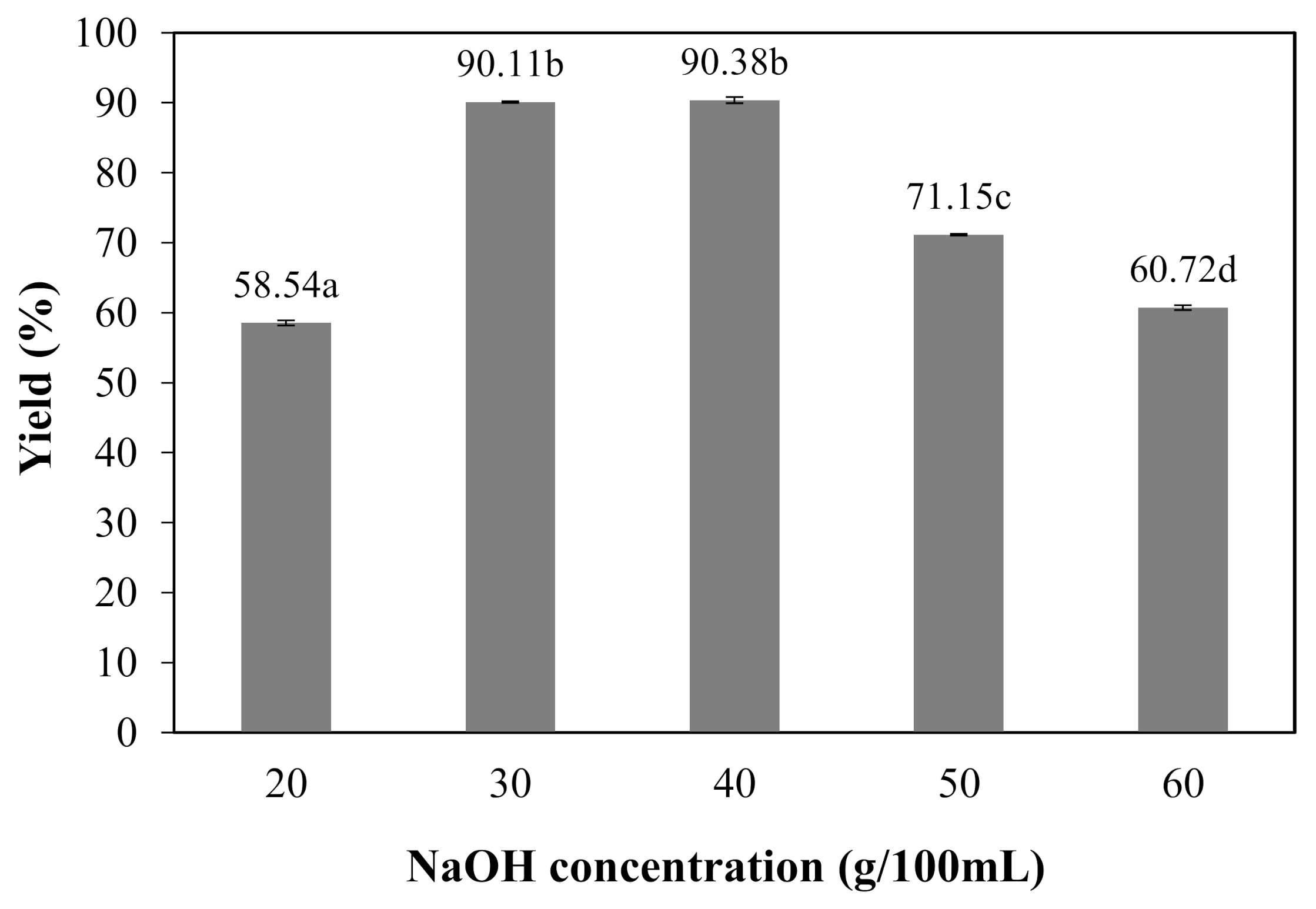


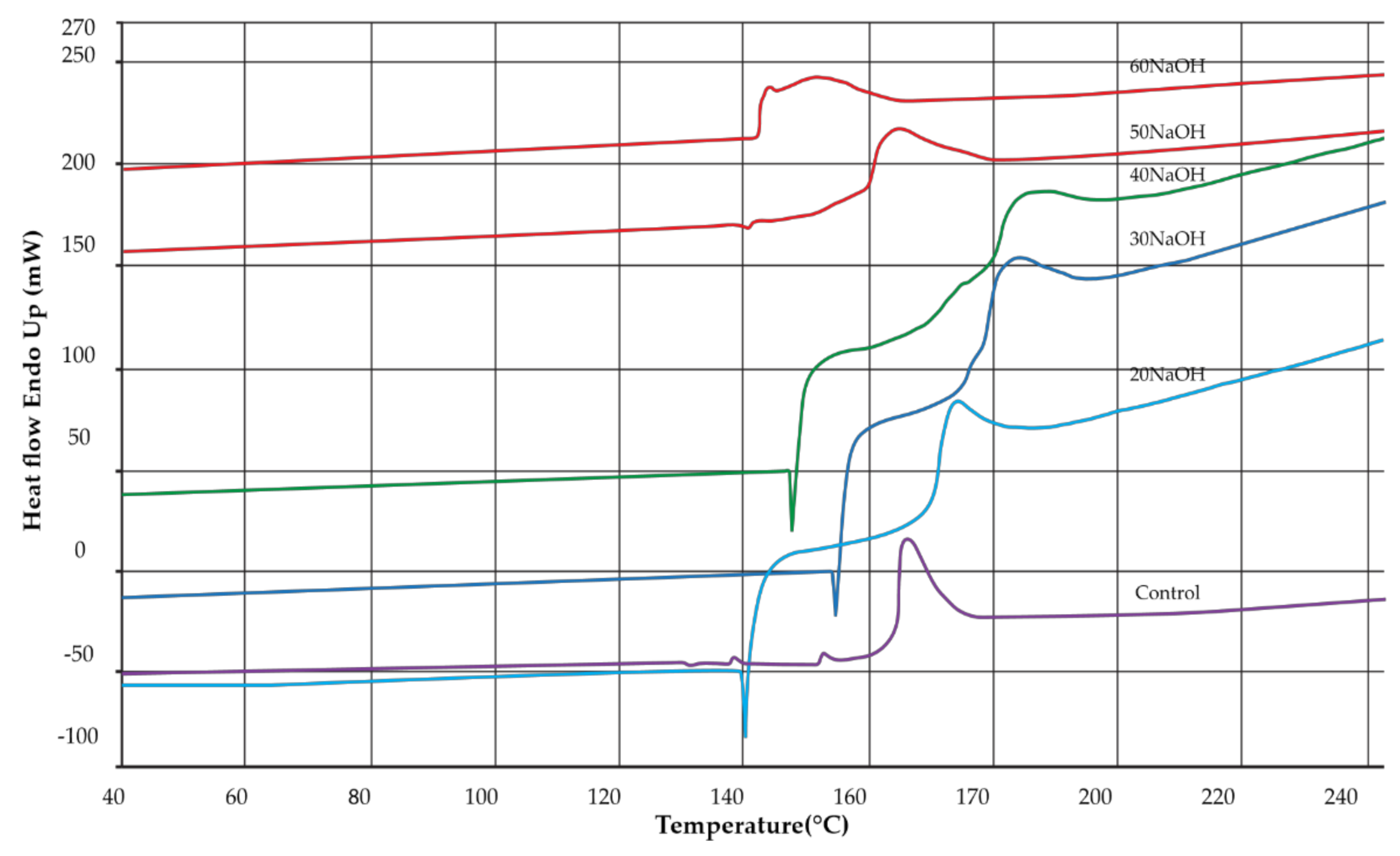
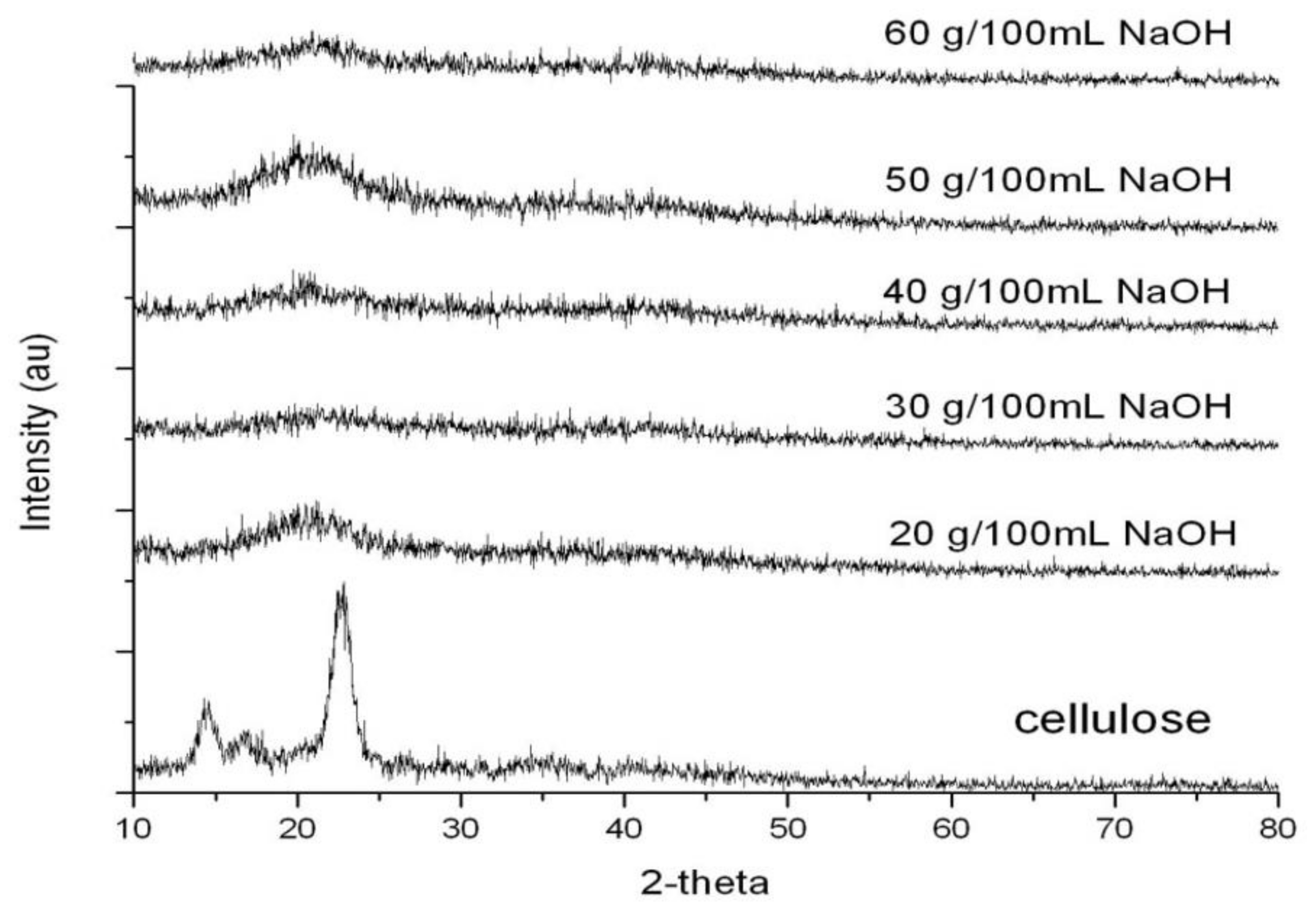
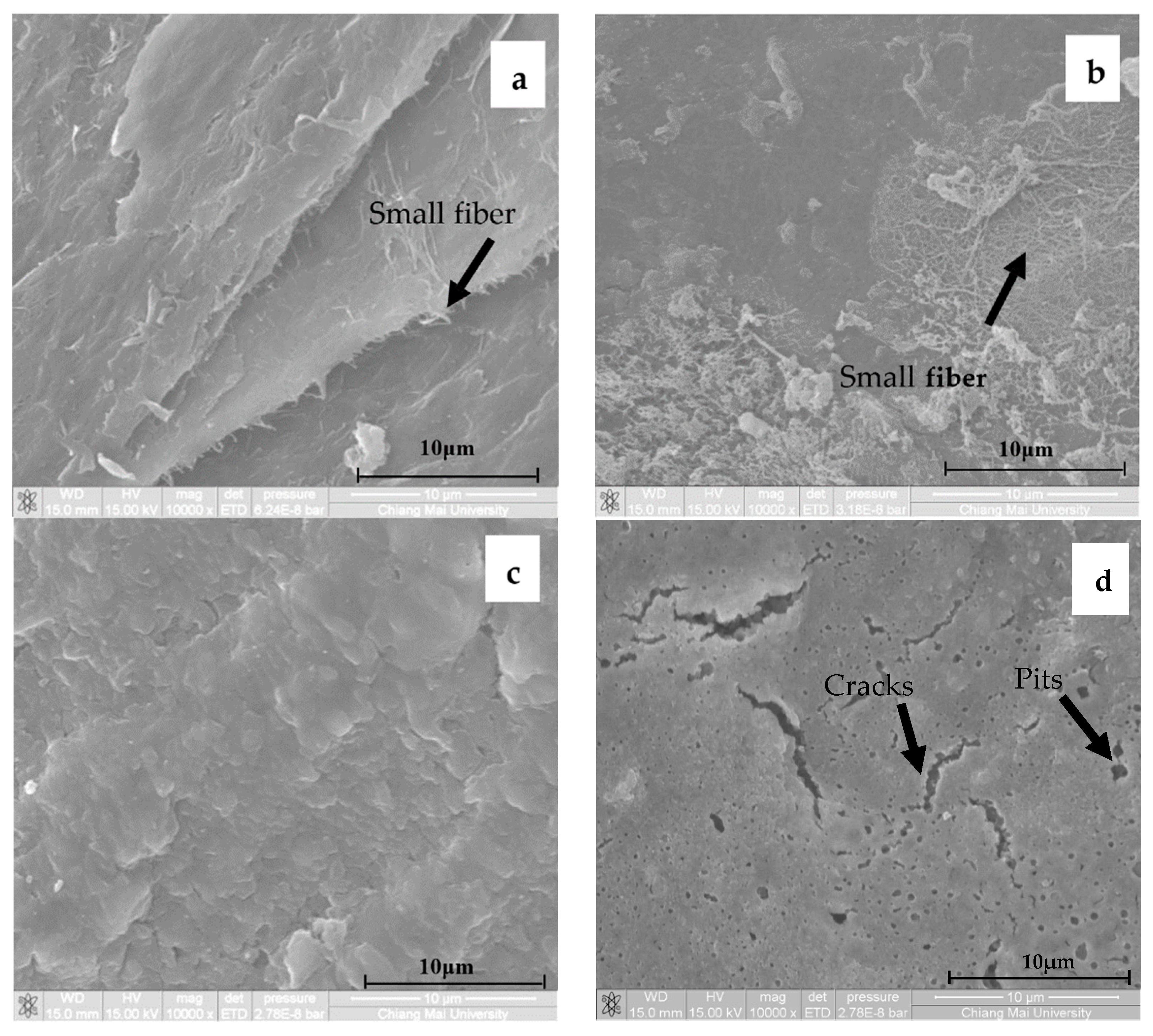
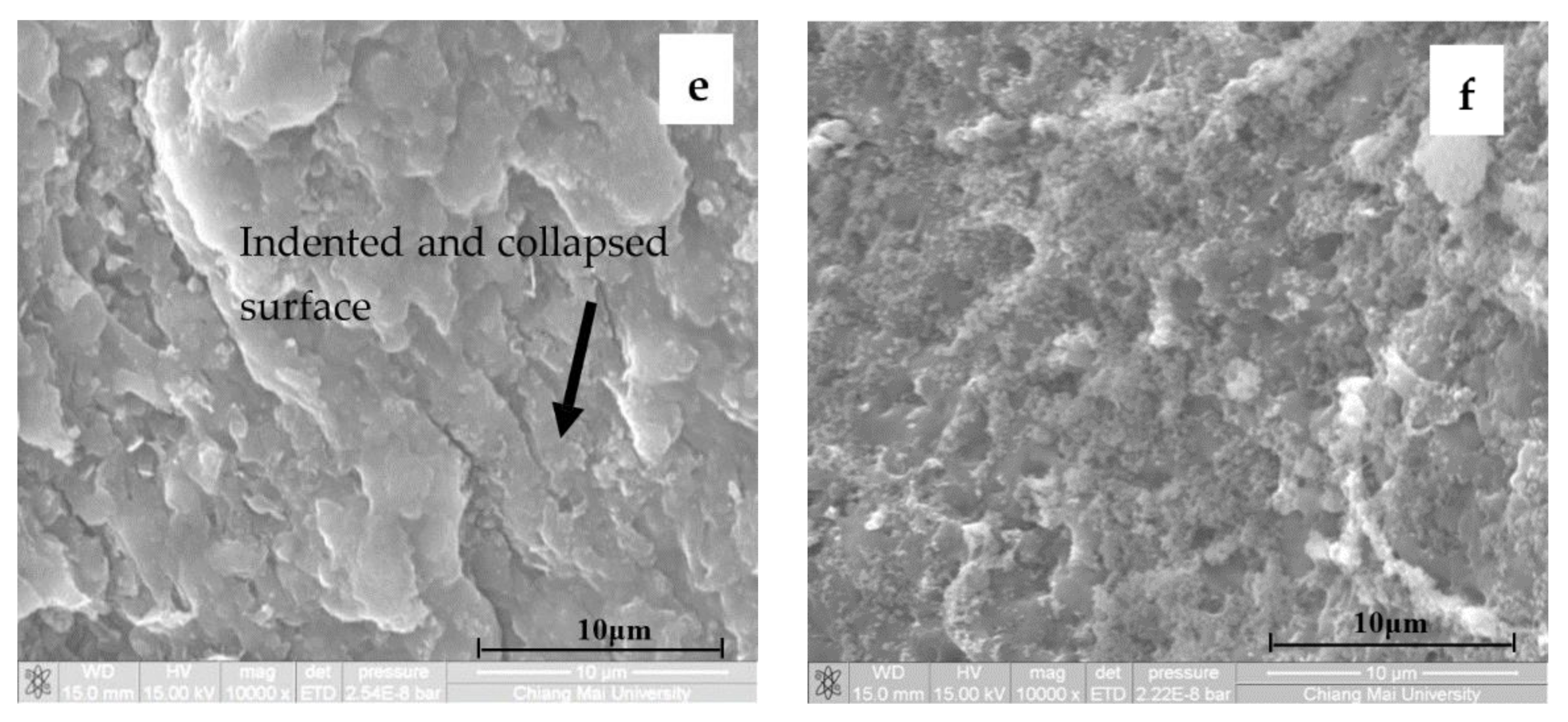
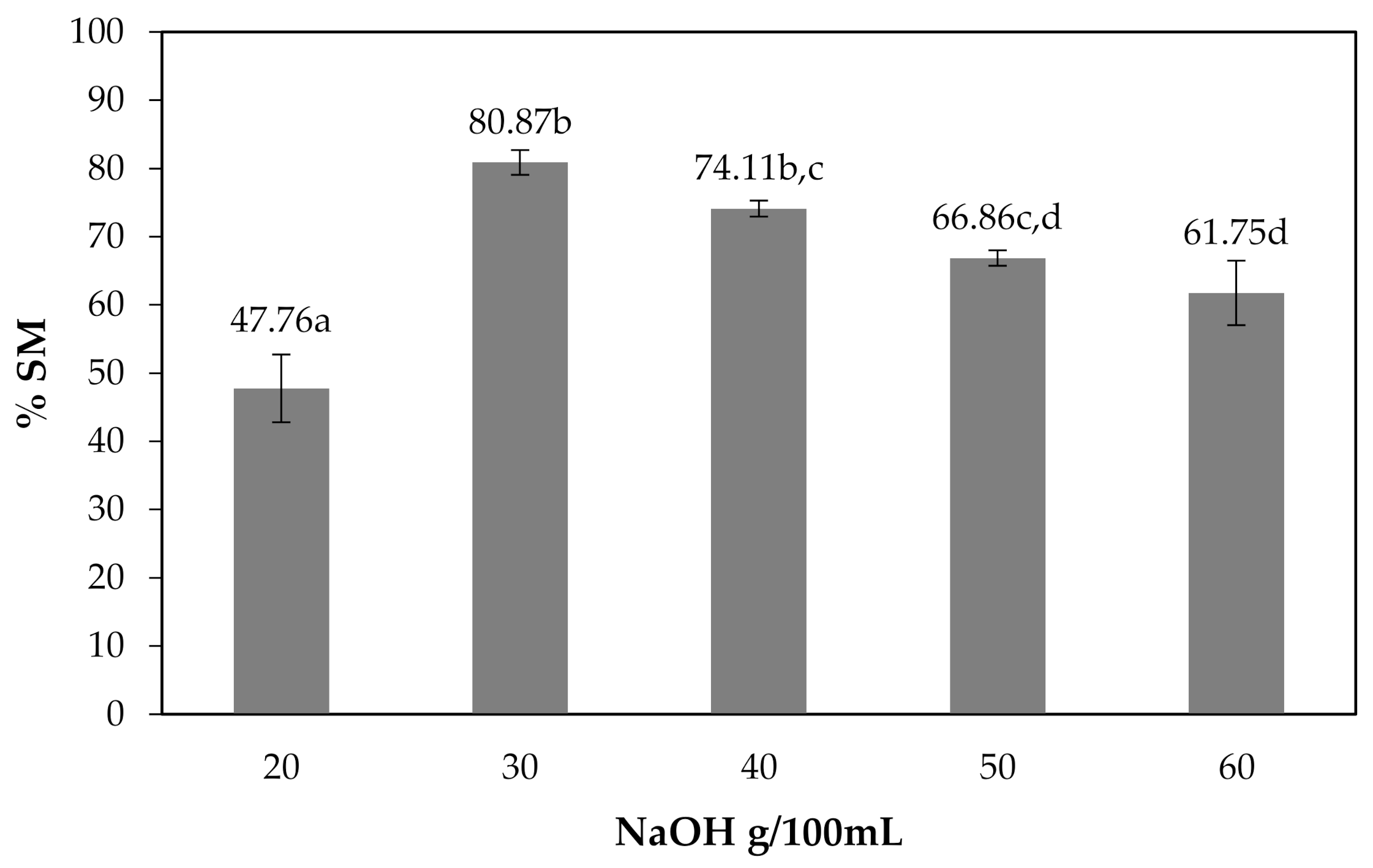

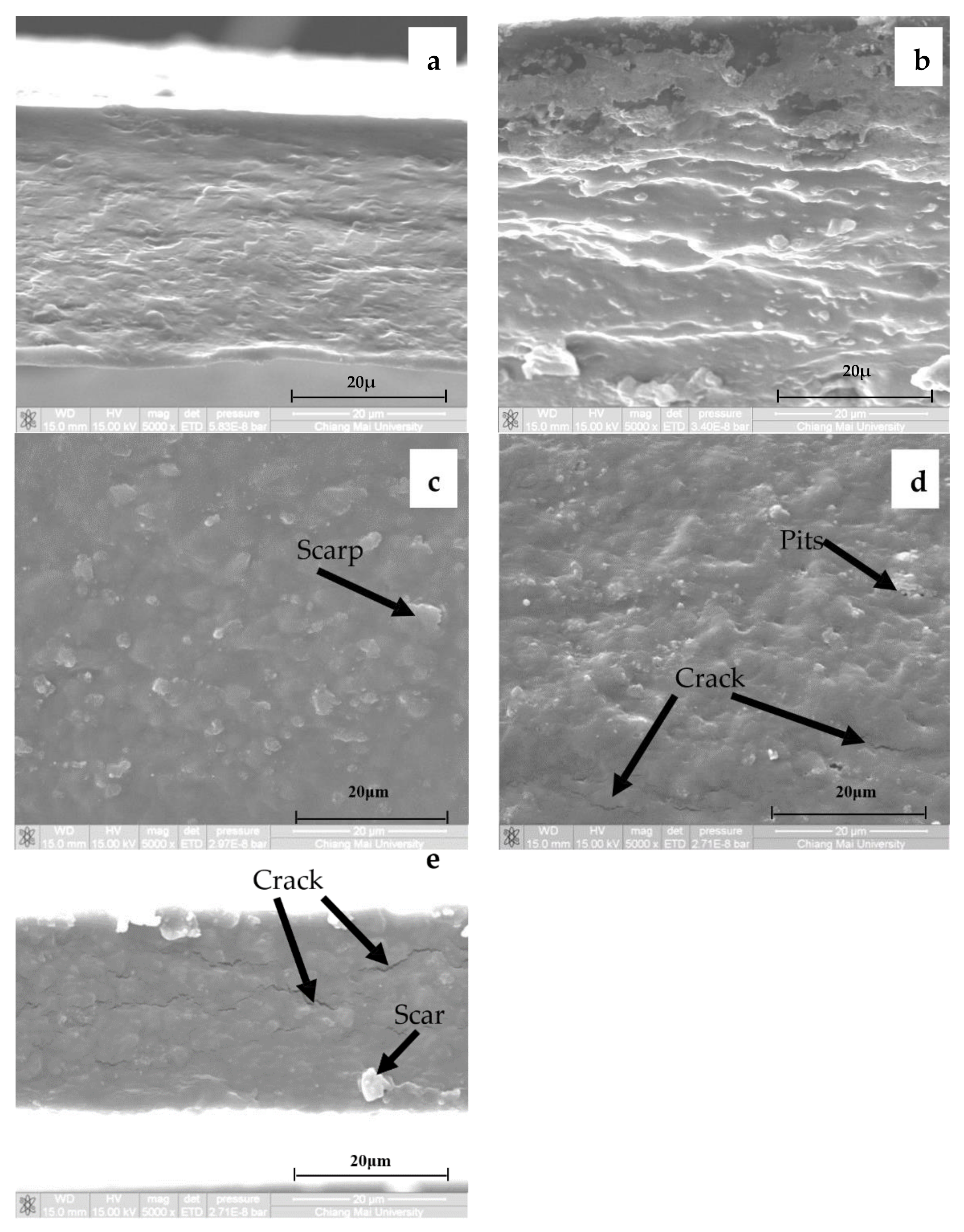
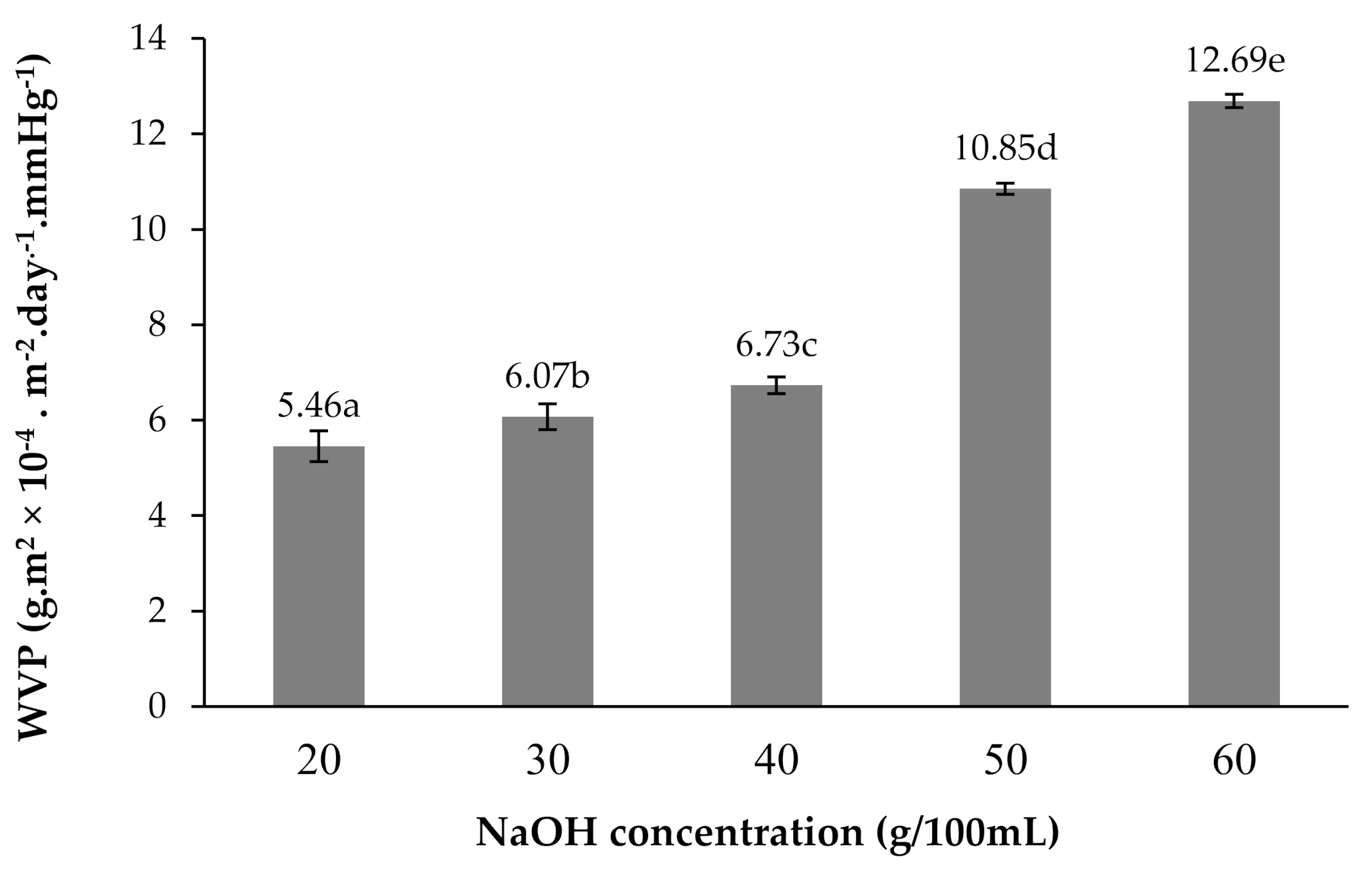

| NaOH (g/100 mL) | L* | a* | b* | ΔE | YI | WI | hab |
|---|---|---|---|---|---|---|---|
| 0 | 75.62a | 2.247a | 16.62a | 23.39a | 31.42a | 70.45a | 82.34a |
| 20 | 64.79b | 8.23b | 28.61b | 40.29b | 63.09b | 54.70b | 73.94b |
| 30 | 65.54b | 10.19c | 28.96b | 40.61b | 63.26b | 54.74b | 70.60c |
| 40 | 74.34a | 7.23d | 22.14c | 29.08c | 42.55c | 65.99c | 71.91d |
| 50 | 70.01c | 7.67e | 21.64c | 31.85d | 44.22c | 62.92d | 70.49c |
| 60 | 68.14d | 7.47de | 21.13c | 32.89d | 44.30c | 61.67d | 70.54c |
Publisher’s Note: MDPI stays neutral with regard to jurisdictional claims in published maps and institutional affiliations. |
© 2021 by the authors. Licensee MDPI, Basel, Switzerland. This article is an open access article distributed under the terms and conditions of the Creative Commons Attribution (CC BY) license (http://creativecommons.org/licenses/by/4.0/).
Share and Cite
Rachtanapun, P.; Jantrawut, P.; Klunklin, W.; Jantanasakulwong, K.; Phimolsiripol, Y.; Leksawasdi, N.; Seesuriyachan, P.; Chaiyaso, T.; Insomphun, C.; Phongthai, S.; et al. Carboxymethyl Bacterial Cellulose from Nata de Coco: Effects of NaOH. Polymers 2021, 13, 348. https://doi.org/10.3390/polym13030348
Rachtanapun P, Jantrawut P, Klunklin W, Jantanasakulwong K, Phimolsiripol Y, Leksawasdi N, Seesuriyachan P, Chaiyaso T, Insomphun C, Phongthai S, et al. Carboxymethyl Bacterial Cellulose from Nata de Coco: Effects of NaOH. Polymers. 2021; 13(3):348. https://doi.org/10.3390/polym13030348
Chicago/Turabian StyleRachtanapun, Pornchai, Pensak Jantrawut, Warinporn Klunklin, Kittisak Jantanasakulwong, Yuthana Phimolsiripol, Noppol Leksawasdi, Phisit Seesuriyachan, Thanongsak Chaiyaso, Chayatip Insomphun, Suphat Phongthai, and et al. 2021. "Carboxymethyl Bacterial Cellulose from Nata de Coco: Effects of NaOH" Polymers 13, no. 3: 348. https://doi.org/10.3390/polym13030348
APA StyleRachtanapun, P., Jantrawut, P., Klunklin, W., Jantanasakulwong, K., Phimolsiripol, Y., Leksawasdi, N., Seesuriyachan, P., Chaiyaso, T., Insomphun, C., Phongthai, S., Sommano, S. R., Punyodom, W., Reungsang, A., & Ngo, T. M. P. (2021). Carboxymethyl Bacterial Cellulose from Nata de Coco: Effects of NaOH. Polymers, 13(3), 348. https://doi.org/10.3390/polym13030348












